Experimental Objective
The main objective of this experiment was to compare the resistance to turning courtesy of friction in four cantilevered bearings made from different materials. As such, a glimpse of the progress made in bearing development would be highlighted.
Theoretical Background
By definition, friction is a kind of a force plying between two bodies that are in relative motion. Basically, owing to the principle of conversation of energy that it can neither be created nor destroyed but transformed from one form to the other, in friction, energy is transformed from kinetic energy to heat. As such its effects are grave on the life of parts of a machine in relative motion since it results in wear and tear. To this end, the efficiency of a machine reduces significantly. Consequently, engineers and designers are challenged to devise means of averting this trend. As such, several methods have been brought on board including lubrication and bearings.
All machines employ spindles or shafts enclosed within bearing systems to aid in free and soft relative motions. Back in history, there has been an evolution in the design of bearings making use of a diverse range of materials including wood, metals, metal alloys, and even nylons. On a broader scope, “bearings can generally be classified into two types: the ‘plain’ bearings and the ‘ball and roller’ bearings” (Beer and Russel, 1996). The difference comes with the design.
While the former uses cylinders in direct contact with a shaft and hence produce sliding friction, the latter has steel balls enclosed within two cylindrical surfaces thereby producing rolling friction. Of the two types, the ‘ball and roller bearings are the most efficient since the severity of the rolling friction is negligible as compared to the sliding friction. To this end, lubrication aids in mitigating the potency of friction. Novel generations of ‘plain’ bearings have an inbuilt lubricating system and hence are ‘self-lubricating.’ This minimizes the difficulties seen in lubricant supply.
While ‘ball and roller’ types need less attention and lubrication contrary to their counterpart- the ‘plain’ bearing, they are relatively more expensive. As regards applications, different types are preferred for different machinations. As such, ‘ball and roller’ bearings find their wide applications in car engines and wheels while self-lubricating bearings are popular in electric motors. On the other hand, wood and steel bearings are commonplace in windmills.
Experimental Procedures
In this experiment, analyses on the resistance to relative motion on bearings were done on four bearing types but one at a time. The bearing types included: the ‘wood and steel,’ ‘brass and steel,’ ‘self-lubricating brass and steel’ and the ‘ball’ bearings.
As such, a mounting panel was mounted but vertically with a bearing assembly fixed on it. A cord was wound but once around a bearing after which equal masses (1N) on either side of the cord were suspended. Masses were gradually added to one end of the cord to the point of making the other end just start rising (Fig. 1). To enhance motion, light tapping on the cord was allowed to overcome static friction. Data of additional weight (F) against the total sum of weight supported by the pulley (W) and F were then recorded for analysis. A graph of F against (W+F) was then plotted. The other bearings too followed a similar procedure after which a comparison of the different graphs was done.
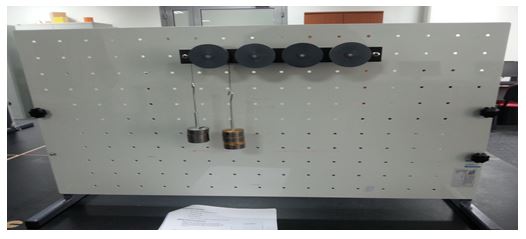
Experimental Data
Table 1: showing the values of F and (W1+F) for different types of bearing designs.
Data Analysis
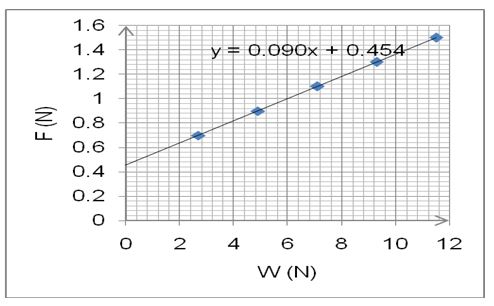
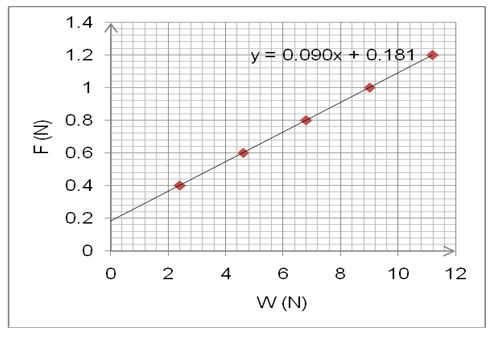
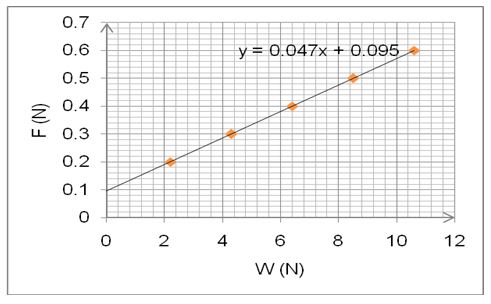
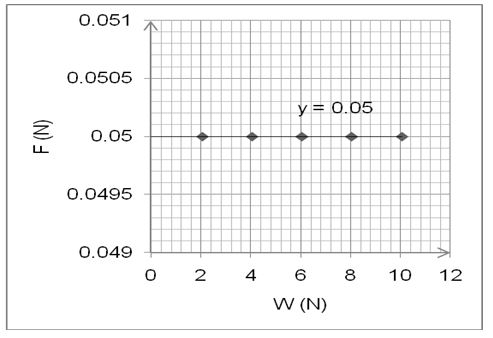
Discussion
The essence of performing this experiment was to analyze the efficiency of bearing concerning design and material of manufacturing used. As such, an analysis of the static and kinetic frictional forces would shed light on the most efficient bearing assembly. As regards this experiment, the acceleration due to gravity on the masses suspended on one end of the cord to effect motion provides the kinetic frictional force (Fµk). On the other hand, the sum total of all the masses (W) suspended by the pulley represents the normal reaction force (Beer and Russel, 1996).
As such, a plot of F against W should result in a straight line with the gradient of the slope representing the coefficient of friction (µ) giving a glimpse of the degree of freeness in motion of a given bearing assembly. To this end, the degree of freeness in motion is inversely proportional to the coefficient of friction. Vitally, extrapolating the graph to meet the y-axis when W is null gives us the static frictional force (Fµs) of a material. Static frictional force ought to be greater than kinetic frictional force. As such, a plot of resistive frictional force against applied force should result in the graph below:
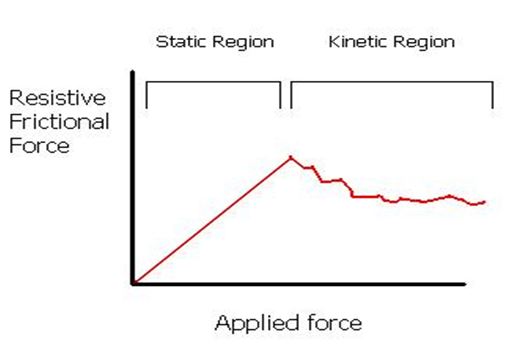
From the graph above, it is clear that a lot of force needs to be applied to a body at rest to overcome the static frictional force before the body breaks freely sliding along the plane with minimum force. Significantly, the body would maintain the status quo if the frictional static force exceeds the applied force.
As regards the analyses above it is evident that of the four bearing assemblies the ‘ball bearing,’ with zero as the gradient, is the most efficient machine. On the contrary, ‘wood and steel’ together with ‘brass and steel’ are the least efficient of them all. The degree of freeness in motion of the bearings follow the trend below:
the degree of freeness in motion of bearings in ascending order ‘wood and steel’ and ‘brass and steel’ < ‘self-lube’ < ‘ball bearing’
From the analyses above as portrayed by the graphs above, it is evident that the static frictional forces exceed the kinetic frictional forces in all the bearing assemblies. For instance, ‘brass and steel’ has an Fµsof 0.454 and an Fµkof 0.09. On the other hand, ‘brass and steel’ has an Fµsof 0.181 and an Fµkof 0.09 while a ‘self-lube’ has Fµsand Fµkof 0.095 and 0.047 respectively. Interestingly, the ‘ball bearing’ has a zero Fµkand an Fµsof 0.05. To this end, once started, a ‘ball bearing’ requires an infinitely small force to maintain the motion.
As regards plain bearings, the choice of the material used determines the durability and application. For this case; steel brass bearings boast an unrivaled hardness of about 2400 Mpa. With a high carbon ratio, the strength is guaranteed and has good conductivity vital in heat conduction. However, with a high percentage of iron, the bearing is prone to rust hence a lot of attention as regards lubrication is required. On the other hand, wood steel bearings require less attention vis-à-vis steel brass bearings because the wood can retain lubricants. However, they are used under low pressure and speed. Self-lube bearings offer performance and maintenance-free characteristics that require absolutely no attention. As such, they are applicable in electric motors to avoid re-lubrication seen in other bearings that may result in lubricant breakdown due to contaminants. Also, re-lubrication may result in churning leading to the same problem.
For plain bearings, friction between the moving parts may be checked by the introduction of highly pressurized fluid between the moving bodies or, the application of low viscous fluids e.g. lubricants. Also, one can exploit electromagnetic fields as well as choose compatible materials for the same.
The fundamental difference between ‘ball’ and ‘plain’ bearings is that the former last longer. The latter is prone to wear and tear however; they are less noisy than ball bearings.
Conclusions
In a conclusion, the objective of the experiment was met since it was established that the degree of efficiency was high in ‘ball bearings’ and least in both brass and wood combinations with steel. Ball bearings are the most recent and efficient designs for bearing assemblies.
References
Beer, F., & Russel, J. (1996). Vector Mechanics for Engineers(Sixth ed.). New York, NY: McGraw-Hill.